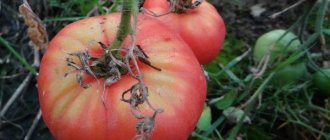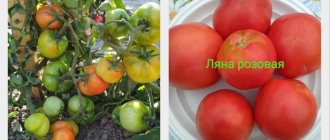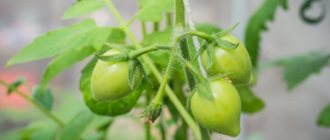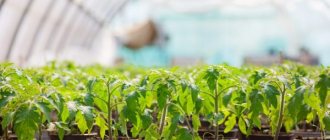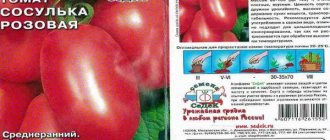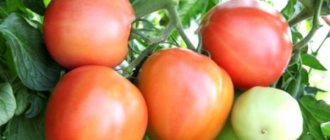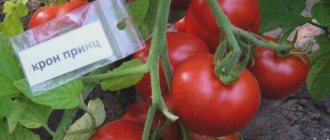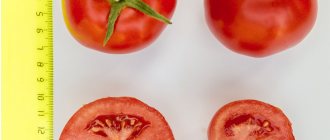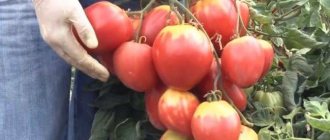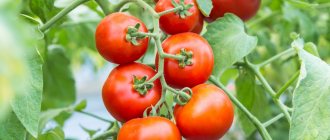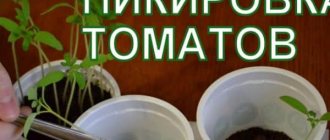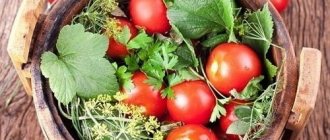True farmers have tried, are trying and will try new varieties of tomatoes. Agrotechnicians recommend Rosamarin pound to all gardeners and farmers - a fleshy, highly productive, tasty variety.
| Height | Landing location | Ripening time | Fruit color | Fruit size | Origin | Fruit shape |
| Tall | Greenhouse, Open ground | Mid-early | Reds | Large | Variety | Flat-round |
general description
Rosamarin pound is a tomato variety bred by Russian breeders.
In 2008 it was included in the Russian register. It is produced by various manufacturers, in particular Gavrish. Since Rosamarin pound is a cultivar, the seeds from the fruit can be used for planting. They are collected from berries ripened on the bush, washed and dried. Store planting material in fabric bags.
Distinctive features
Rosamarin pound differs from other varieties in the unusual shape of its fruit. Its berries are deep pink inside and out. They are round, flattened on both sides, with pronounced ribbing at the base, which extends onto the body of the tomatoes, literally dividing them into slices.
A photo of the fruit is presented below.
The pulp of such fruits is tender and literally melts in your mouth. It has a sweet taste with barely noticeable sourness.
The berries are large. Each of them weighs almost half a kilogram. It is for its large fruit that the tomato received the name Rosamarin pound.
Another distinctive feature of the variety is the increased content of vitamin A in the fruit pulp. Therefore, it is especially useful for children and people suffering from cardiovascular diseases.
The tomato is immune to the most common nightshade diseases. He is not afraid of late blight either. This greatly facilitates cultivation and reduces the need to use chemicals.
Rosamarin pound has high immunity and excellent taste of the fruit. The description of this variety will please even experienced gardeners.
| Parameter | Indicators |
| Bush type | Indeterminate variety (grows throughout the entire growing season). The height of the main stem reaches 1.5 m. The bushes are covered with a moderate amount of foliage. The leaf blade is long and narrow, wrinkled, simple in shape and dark green in color. The stems are thick and powerful. The inflorescences are simple, the first is formed in the axil of the tenth leaf, and the rest every 2-3 leaves. The rhizome is powerful, it grows greatly in breadth. |
| Growing method | In the southern regions it is recommended for planting in film shelters. In the central part of the country - in unheated greenhouses, in the northern regions - in heated rooms. |
| Productivity | High. From 1 sq. m, 10–15 kg of fruits are collected. |
| Fruit | Large ones. One berry weighs on average 500 g. Some specimens reach a weight of 1000 g. The color of the fruit is bright pink inside and out. The presence of yellowish and greenish spots may be present. The shape of the fruit is round, flattened on both sides. There is pronounced ribbing at the base, which extends to the rest of the body of the fruit. The pulp of the berries is tender and juicy, melting in your mouth. The taste is sweet, with slightly pronounced sourness. Inside each fruit there are eight chambers with small seeds. |
| Transportability | Low. Berries are easily damaged during transportation. They are stored for no more than two weeks. |
| Ripening time | Mid-season variety. The fruits ripen 110–115 days after sowing the seeds. Fruiting continues all summer. |
| Disease resistance | Is immune to most tomato diseases. Not afraid of late blight, fusarium, tobacco mosaic, cladosporiosis. |
Description and characteristics of the variety
Rosamarine pound is an indeterminate tall variety. Included in the State Register since 2008. Initially intended for cultivation under film, but in warm regions planting in open beds is possible.
Features of the bushes:
- shoot height 1.7-2 m;
- powerful stems;
- number of tomatoes per bunch 5-7;
- 7-8 tomato bunches.
The ripening time for Rosemary pound from Gavrish is average - 115-125 days from germination. Description of tomatoes:
- average weight 350-450 g;
- color bright red;
- the pulp is fleshy, oily, moderately juicy;
- oblate spheroid shape;
- the skin is strong;
- seed chambers within 4-6.
The taste is a harmonious combination of sourness and sweetness. The pulp resembles watermelon.
Features of care
Tomatoes are grown in seedlings. The key to success is high-quality seed purchased from a trusted manufacturer.
At the end of March, pre-planting preparation of seeds is carried out: dressing in a solution of potassium permanganate (1%) and preparing the soil mixture - a mixture of humus and peat, heated in the oven at 100-110 °C.
In early April, the soil substrate is poured into a planting container, shallow grooves (1.5-2 cm) are made in one direction, and water is spilled.
To speed up germination, seeds are treated with growth stimulants before sowing.
Tomatoes are sown at a distance of about 1.5-2 cm from each other, sprinkled with a minimum layer of soil mixture and covered with film or glass until shoots appear. The soil should always remain moist and warmed by the sun to 24-25 °C.
The soil should be moist and warm.
After the emergence of seedlings, the shelters are removed and the temperature in the room is gradually lowered. At the stage of 3-4 true leaves, the seedlings are planted in individual containers.
The final planting to a permanent place in the greenhouse is carried out in May, at an air temperature of at least 10 °C. It should be borne in mind that Rosemary F1 tomatoes, by all descriptions, are very powerful plants; seedlings must be planted at a distance of at least 0.6-0.7 meters from each other. Per square meter of area - no more than 3-4 plants.
For full development, tomatoes require:
- Light soil enriched with organic and mineral substances;
- Watering with warm water 1-2 times a week and loosening the soil;
- Feeding 3-4 times per season;
- Pinching, as the side shoots grow;
- Bush formation;
- Pinching the crown;
- Supports and garters for stability;
- Treatments for diseases and pests.
The best predecessors of tomatoes are green manure plants, which are embedded in the soil as a natural fertilizer and to improve air permeability. If the soil is heavy, then sand is added before digging; with high acidity, lime is added. Add mineral fertilizers (for example, azofoska) directly to the planting hole before watering it.
Watering and loosening
For Rosemary tomatoes, watering is especially important. With an acute lack of moisture, juicy fruits crack and quickly deteriorate. Cold water will stress the root system of the tomato bush. It can drop ovaries and unripe fruits. After each watering (under the root), the soil around the bush is loosened and mulched to avoid the formation of a crust.
Loosening the soil
Feeding
The first feeding is carried out 10-15 days after planting the tomatoes in a permanent place. Nitrogen-rich organic or complex fertilizers are most suitable for this. The second important point will be the introduction of complex mineral supplements during the flowering of tomatoes. Subsequent feeding is carried out after the main mass of fruits has set in order to support the plant at this stage.
Stepsoning
The procedure allows you to correctly form the bush, directing the vitality of the tomato to increase productivity, and not to the growth of shoots and leaves. Experienced vegetable growers inspect growing shoots 1-2 times a month. The tops of all saved stepchildren are pinched.
Bush formation
Rosemary is usually grown in 2 or 3 stems. The most developed stepsons are selected, tied up and cut off along with the main trunk.
Garter of tomatoes
A characteristic feature is that when grown in 2 stems, the fruits are larger. When a tomato bush is formed into 3 stems, there are more fruits, but they are smaller. Thus, the choice of the type of bush formation does not affect the yield if measured in kilograms.
The crown of the central shoot is pinched when they want to limit the growth of the tomato and direct all their efforts to the ripening of the formed fruits.
Tomatoes of the Rosamarin Pound variety are grown exclusively with the help of a garter to trellises (supports). For all its stately power, the bush is not able to withstand the load from the growing crop. Without a garter, the branches will break off. To successfully garter a heavy bunch, it is better to use a special holder or a nylon net with a garter on a trellis. Not all fruits ripen on the bushes; sometimes it makes sense to pick the fruit and let it sit outside the greenhouse until ripe.
Tomato in a greenhouse
A clear advantage over other tomato varieties is their stable immunity to major diseases, which kill most Solanaceae plantings. Pink-fruited tomatoes of this variety are affected by late blight much later and less often than other tomatoes.
The Rosemary tomato has a tendency to curl its leaves, which is not caused by viral or bacterial diseases, but by high sensitivity to a deficiency or excess of microelements in the soil.
The bushes should be fed with complex fertilizer for tomatoes. If excess nitrogen is visible from the rapid growth of leaves and shoots, you should feed with ash.
Another good reason for curling tomato leaves is an uncomfortable microclimate in the greenhouse. In hot weather, plants can “cook” without ventilation. Insufficient and excess moisture becomes a serious test for tomatoes.
Do not over-water the soil
Pests live on all tomatoes, regardless of the variety. Sap-sucking: aphids, whiteflies and spider mites are visible on the leaves. Treatment with a thick solution of laundry soap will help here. Pests that gnaw at roots (mole crickets, moles) are caught using special traps.
The timing of sowing seeds is from February to April.
The depth of the soil is 1-2 cm in a moistened soil mixture, which is prepared on the basis of garden turf. Disinfect with 1% potassium permanganate. Care secrets:
- Until germination, the boxes are kept warm under film.
- Irrigate with settled water through a spray bottle.
- Add complex fertilizers “Kemira” or “Agricol”.
- They dive when there are 2-3 true leaves.
Medium early/Tall
User rating: 4/5
Early maturing / Tall
User rating: 5/5
Mid-season / Tall
Growing seedlings
Growing tomato seedlings yourself is not difficult. If you follow the basic rules of sowing seeds and caring for seedlings, the plants will be strong and healthy.
Seeds are sown in early May. Since growing tomatoes of this variety is possible only in protected soil, the planting time will be the same for each region.
Seed preparation
Seeds should be prepared in advance for planting. This will increase the resistance of tomatoes to diseases and negative environmental conditions and accelerate the germination of planting material:
- Before purchasing seeds, be sure to check expiration dates. All information must be indicated on the packaging.
- Seeds are checked for germination. They are soaked in a solution prepared from a glass of water and a teaspoon of salt for half an hour. Specimens that float up are thrown away, and those that sink to the bottom are used for planting. They are washed under running water.
- Planting material is disinfected. To do this, soak for 20–30 minutes in a light pink solution of potassium permanganate or hydrogen peroxide, then rinse under running water.
- Then a growth stimulator is used. This remedy is prepared from a glass of water with a teaspoon of honey. Purchased compounds are also used, for example, “Epin”, “Zircon” and “Sodium Humate”.
To sow large quantities of seeds, use boxes or trays. Cut-off plastic bottles, packages of semi-finished foods and desserts are also suitable.
For picking plants, use containers with a volume of at least 300 ml. Stores sell special pots, but more often gardeners use cut-off bottles and disposable dishes.
If you plan to plant several Rosamarinum bushes, it is more convenient to use peat tablets. In this case, picking is not required.
Containers for seedlings are disinfected. They are poured with boiling water or soaked for half an hour in a solution of potassium permanganate.
It’s easy to prepare soil for tomatoes yourself. Here are some suitable formulations:
- a mixture of peat and sand taken in equal proportions with the addition of ash;
- humus, black soil and sawdust in equal proportions;
- equal proportions of black soil and crushed coconut substrate.
The soil is disinfected. To do this, pour it with a dark pink solution of potassium permanganate, boiling water or copper sulfate. Another option is to calcine the soil mixture in the oven.
Tomato seeds are sown in one large container or individual peat tablets. Sowing technology differs:
- Shared boxes. Soil is poured into the boxes and watered with warm water. Grooves 1 cm deep are made in the soil at a distance of 3 cm from each other. Seeds are placed in the depressions at intervals of 2 cm. They are sprinkled with soil. The containers with seeds are covered with film and put in a warm place.
- Peat tablets. The blanks are placed in a deep container with the hole facing down and filled with boiling water. When they swell, they are taken out and turned over. One seed is placed in each tablet, buried 1 cm. Bags with soil and planting material are placed in one container, covered with film and put in a warm place.
Seedling care
To get healthy and strong plants, you need to properly care for them. Any violations of the growing rules will lead to the death of tomatoes:
- Seven days after seed germination, the film is removed. Before this, it is opened daily for 30–60 minutes for ventilation.
- After removing the film, the tomato seedlings are moved to a well-lit place. You may need to use a fluorescent lamp.
- Water the seedlings at the root as the soil dries. The liquid should be at room temperature.
- After the true leaves appear, the plants are planted in individual pots with a layer of drainage at the bottom. This will reduce the risk of blackleg infection. Water and feed after picking two weeks later.
- During the period of growing seedlings, fertilizers are applied only three times. Use complex fertilizers containing phosphorus. This microelement promotes the formation of a strong root system.
- 10 days before planting tomatoes in open ground, they begin to harden. Plants are taken outside during the warm part of the day. The first time, the duration of hardening does not exceed half an hour, then gradually the time is increased to 16 hours.
Features of cultivation
Seeds for seedlings are purchased in the store and planted 55-60 days before transferring to open ground. You can buy an earthen composition or prepare it yourself based on sand and peat (in equal quantities) with a pinch of wood ash. The mixture can also be made from turf soil with compost and humus (ratio 2:1:1). It is first spilled with potassium permanganate or hydrogen peroxide or frozen in the freezer for 3-5 days.
The seeds are tested in a 5% salt composition - the floating ones are removed, and the remaining ones are pickled in a fungicide (for example, Maxim) and immersed for several hours in a solution of a growth stimulator (Epin, Zircon). For planting, use peat tablets, cassettes, wooden boxes or other containers (later placed in plastic glasses or peat pots).
The sequence of actions is as follows:
- Place the soil in a container and make furrows 2 cm deep at the same intervals.
- Place the seeds at a distance of 3 cm from each other and sprinkle with soil.
- Moisturize generously from a spray bottle.
- Cover with film with holes and place in a warm place at a temperature of 25 degrees.
- After 2 leaves appear, they are planted in individual containers.
- The temperature is reduced to room temperature.
- A week later they are fed with complex mineral fertilizer.
- 2 weeks before transferring Rosemary tomato seedlings, they are hardened at a temperature of 17-18 degrees.
After picking, the seedlings are transferred to individual containers
Rosemary tomato seedlings are transferred to open ground in mid-May, and to a greenhouse 1-2 weeks earlier (in the south it is possible at the end of April). Since Rosemary tomato bushes are not very spreading, you can maintain a distance of 40 cm between them (the interval between rows is 50 cm). Any planting pattern is allowed - in a line or in a checkerboard pattern.
Standard agricultural technology for growing Rosemary tomatoes:
- Watering once a week (2 times in drought) with warm, settled water.
- Mulching with peat, straw, sawdust.
- Fertilizing 2 times a month: organic matter (litter, mullein) alternating with complex mineral fertilizer.
- Garter to support.
- Pruning, weeding and loosening as necessary.
Important! The Rosemary tomato bush is usually formed into 1 trunk. But to increase productivity, you can form 2 stems. Thanks to abundant but moderate watering and regular fertilizing, Rosemary tomatoes will be tasty and juicy
Thanks to abundant but moderate watering and regular fertilizing, Rosemary tomatoes will be tasty and juicy
Features of care
Watering and loosening
Loosening the soil
Bush formation
Garter of tomatoes
Agricultural technology Rosamarina pound
Rosamarin pound is grown only in protected soil. It is under such conditions that the highest yields are recorded.
You can plant seedlings in a permanent place in early March. In protected soil, the soil will already be quite warm during this period.
Transplanting
Before planting tomatoes, prepare the soil. In autumn, the beds are dug up and cleared of plant debris. For 1 sq. m add 4 kg of humus. If the acidity of the soil is increased, it is reduced with dry lime.
In the spring, the beds are leveled with a rake, cleared of weeds, and watered with copper sulfate.
The holes are dug in rows in a checkerboard pattern. For 1 sq. m no more than three plants are planted. With a denser planting, fewer fruits will be produced on the bushes.
1 tbsp is poured into the bottom of each hole. l ash. Plants are placed in them, forming roots towards the center. The holes are covered with earth, each one is watered with a liter of water.
Tomato care
Tomato Rosamarin pound should be tied up. It is more convenient to use trellises, but wooden supports will also work. The plant is attached to the support as it grows with a synthetic thread that does not rot.
When forming a bush, one or three stems are left. The fewer trunks remain, the larger the fruits will be and the sooner the harvest will ripen.
During the pinching process, leaves up to the first cluster and withered greenery are removed. The procedure is carried out once a week. No more than three leaves are removed in one session.
Water the soil as it dries out. Use warm, settled water. If the liquid gets on the above-ground part of the plants, the likelihood of burns on the leaves will increase. Watering should be plentiful, but infrequent.
After each moistening of the soil, it is loosened. This prevents the formation of an earthen crust, which interferes with air exchange. During this procedure it is convenient to remove weeds.
Tomatoes are fertilized with complex mineral and organic fertilizers. They must contain phosphorus and potassium. Before applying fertilizing, moisten the soil abundantly.
Features of care
Rosamarinum pound will produce a bountiful harvest if properly cultivated. It has care features that every gardener needs to know about:
- Rosamarin pound is prone to fattening. With an excess of nutrients, it forms few ovaries, and the leaves begin to curl. Tomatoes of this variety are fed only twice a season.
- If the tomato is not fed at all, the fruits will crack. It is important to use moderation when using fertilizers.
- Be sure to help pollinate the inflorescences of Rosamarinum pound. To do this, the bushes are shaken regularly.
- Tomato beds are mulched. They are covered with straw, humus or hay.
Diseases and pests
Rosamarin pound has high immunity to various tomato diseases. However, it is worth following the rules of prevention:
- Seeds, soil and containers are disinfected. Garden tools are also treated with copper sulfate.
- It is important to monitor soil moisture.
- The bushes are sprayed with a solution prepared from a piece of laundry soap rubbed into a bucket of water. This mixture protects tomatoes from aphids, spider mites, Colorado potato beetles and other insects.
Prevention of diseases and pests
Hybrid Rosemary is protected at the genetic level from infection by viral diseases of nightshades (verticellosis, fusarium, tomato mosaic). Seed producers claim that the crop is not afraid of late blight (brown spots, whitish coating on leaves and trunks, ugly shape of fruits).
However, prevention will not be superfluous:
- soil treatment with copper sulfate;
- disinfection of greenhouses with sulfur bombs;
- removing lower yellowed leaves;
- control of moisture level in the greenhouse;
- moderate watering at the root;
- covering the soil with mulch.
The main problem that gardeners face when cultivating tomatoes is leaf curling. If measures are not taken in time, you may be left without a harvest. The reason for this condition lies in an excess of organic fertilizers in the soil, the air temperature in the greenhouse is above +32 ° C, and a deficiency of copper.
Ways to solve the problem:
- application of phosphorus-potassium fertilizers;
- treatment with the preparation “Agrofon” containing copper;
- ventilation of greenhouses to normalize temperature conditions.
The hybrid is often attacked by mole crickets, Colorado potato beetles, whiteflies, aphids, and caterpillars. Modern safe insecticides help fight pests: “Grom”, “Fitoverm”, “Iskra”, “Force”, “Epin”, “Konfidor”, “Commander”.
Advantages and disadvantages
Over ten years of testing in summer cottages, the Rosemary tomato has received many reviews characterizing the strengths and weaknesses of the variety.
Advantages:
- Excellent taste of fruits. The tomato has a thin shell with tender and juicy contents that melt in your mouth;
- Huge raspberry-red tomatoes are breaking records in size and weight. Individual specimens – more than 1 kg;
- High content of vitamins in the pulp of the fruit;
- The variety is resistant to major tomato diseases;
- A powerful bush can be formed into 2 (sometimes 3) trunks, on which more fruit vines are formed;
- Does not require special growing conditions;
- Good yield - over 10 kg per bush. Gradual ripening of fruits.
Flaws:
- Tomatoes are not suitable for transportation;
- The fruits cannot be used for preservation;
- The bush requires pinching and pinching;
- You cannot plant your own seeds;
- The plant itself needs additional supports and garters, and the fruit clusters need support;
- Large fruits with a lack of moisture are prone to cracking;
- The harvest does not last long.
According to reviews from gardeners, the Rosemary tomato variety corresponds to the characteristics and description of the variety. Very few vegetable growers abandoned its cultivation. Most summer residents who planted these tomatoes continue to grow them in limited quantities in greenhouses on their plots.
Rosemary is loved by summer residents for the delicate sugar taste of its juicy fruits, stable immunity to many common diseases and unpretentious care requirements.
Advantages of Rosamarin pound:
- high productivity;
- large fruit;
- rich taste of fruits;
- immunity to tomato diseases;
- increased content of vitamin A in berries.
Disadvantages of the variety:
- grown only in protected soil;
- the need for gartering and pinching.
Description of the Rosamarin pound tomato, characteristics and cultivation of a hybrid variety
The Rosamarin pound tomato, the characteristics and description of the variety which will be given below, belongs to the group of hybrids with large fruits. Designed for breeding in greenhouses.
In open ground, this variety is grown under film cover. Cultivated by gardeners who love tomatoes with a sweet taste.
The tomato is used for preparing salads, producing ketchups, juices and sauces.
What does a farmer need to know about the Rosamarin tomato?
This variety has the following characteristics:
- You can get the first fruits of the plant 110-115 days after sowing the seeds.
- The bushes of this tomato are characterized by a large number of leaves, painted in dark tones of green. The leaves have a standard shape for tomatoes.
- The height of a bush with a powerful trunk can reach 1.2-1.3 m, but with all agrotechnical measures and good care of the bushes, they grow in height to 1.7-1.8 m.
- Rosamarin is grown on a trellis with the obligatory garter to a strong support. The hands should also be tied. If these measures are not taken, the branches of the plant may break under the weight of the saturated fruits.
- The vegetables have the shape of a slightly flattened spheroid with slight ribbing in the stalk area.
- The weight of 1 tomato reaches 0.44-0.55 kg. It is painted in bright shades of pink. The pulp of the fruit has the consistency of the inside of a watermelon.
According to reviews from farmers who grow this variety, the Rosamarin tomato has good resistance to diseases such as late blight and fusarium. But to obtain a full harvest, plants of this type are recommended to be grown on light, fairly fertile soils.
You cannot use a lot of fertilizers for feeding, as the leaves of this tomato variety begin to curl due to excess nutrients. With normal plant care, you can get up to 10 kg of fruit from each bush.
Lack of moisture can cause cracks in the tomato skin.
Although Rosamarin has a good presentation, it cannot be transported over long distances, since the fruits are severely damaged along the way. These tomatoes are not suitable for pickling because their skin is too thin, but they are used in various dietary dishes. Pediatricians recommend Rosamarin for feeding children who cannot eat other types of tomatoes or who have been prescribed vitamin A by their doctor.
Throughout Russia, including the southern regions, the described type of tomato is recommended to be grown in greenhouses. In the south, these can be simple film coverings, but in the middle zone and Siberia, Rosamarin is grown in well-heated greenhouses.
How to grow a tomato of this variety yourself?
The described tomato variety does not require any special care measures. Seeds are sown for seedlings in the first week of April. As the farmers who bred these tomatoes indicate, before planting in the soil, the seeds must be treated with potassium permanganate or aloe juice.
After the sprouts appear, they are picked when 2-3 leaves appear on the seedlings. The seedlings are transferred to permanent soil in the greenhouse after preliminary hardening for 7-12 days. The age of the plants by this time will be 50-60 days, counting from sowing the seeds. You cannot plant more than 3 bushes per 1 m².
Excess organic compounds in the soil can be compensated by introducing complex fertilizers into the soil. To do this, use a solution obtained by diluting 1 tbsp. l. fertilizers in 5 liters of warm water.
If the plant lacks copper, it is treated with Agrofon KU-8. The solution contains all the microelements and vitamins that tomatoes need for normal development. High temperatures are reduced by constant ventilation of the greenhouse. Garden pests are controlled with various chemical poisonous solutions.
Cultivation in open and protected ground
Rosamarin pound is grown only in protected soil. It is important to follow a few simple rules:
- Before planting tomatoes, the walls of the greenhouse are treated with copper sulfate.
- In the greenhouse there is increased humidity and the rapid spread of plant infections. To get rid of these shortcomings, the room is regularly ventilated.
- Tomatoes in the greenhouse are watered only once a week.
- To help the plants pollinate, the bushes are shaken regularly. Another option is to install a fan in the greenhouse.
Farmer reviews
Reviews from those who planted Rosamarin pound are mostly positive. This greenhouse variety pays for all the labor with a rich harvest of berries with excellent taste.
Irina, Sochi: “I grow Rosamarin in a film greenhouse. I form it into two stems. During the season, I collect at least half a bucket of tomatoes from each bush. The tomatoes are very beautiful, with a lot of ribs, just like in the photo. They are huge, fully justifying their name, the largest weigh almost a pound. They taste sweet."
Gennady, Murmansk: “I grow Rosamarin pound in a heated greenhouse. This is my favorite variety. It has large, tasty fruits. Plants do not get sick and do not require frequent feeding. I form them into one stem.”
